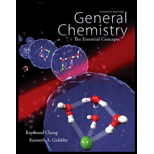
Concept explainers
(a)
Interpretation:
For each of the given redox reactions, the half-cell reactions, the completely balanced cell reaction and the direction of spontaneous reactions has to be found.
Concept Introduction:
Redox reactions are the reactions in which both oxidation and reduction takes place simultaneously. Oxidation is the removal electron from an atom or ion. Oxidation process increases the oxidation number. Reduction is the addition of electron to an atom or ion. Reduction process decreases the oxidation number. The
Standard reduction potential is the measure of the tendency of a species to undergo reduction. It is measured in terms of volts. The substance which is having high positive value will easily undergo reduction.
The standard electrode potential of a cell
The relation between Gibbs free energy and cell potential: The amount of energy in a system that can be converted into useful energy is defined as free energy in
Free energy and the cell potential is related by the given equation.
Where,
(b)
Interpretation:
For each of the given redox reactions, the half-cell reactions, the completely balanced cell reaction and the direction of spontaneous reactions has to be found.
Concept Introduction:
Redox reactions are the reactions in which both oxidation and reduction takes place simultaneously. Oxidation is the removal electron from an atom or ion. Oxidation process increases the oxidation number. Reduction is the addition of electron to an atom or ion. Reduction process decreases the oxidation number. The electrochemical reaction of zinc with copper sulphate is an example of redox reaction.
Standard reduction potential is the measure of the tendency of a species to undergo reduction. It is measured in terms of volts. The substance which is having high positive value will easily undergo reduction.
The standard electrode potential of a cell
The relation between Gibbs free energy and cell potential: The amount of energy in a system that can be converted into useful energy is defined as free energy in thermodynamics.
Free energy and the cell potential is related by the given equation.
Where,
(c)
Interpretation:
For each of the given redox reactions, the half-cell reactions, the completely balanced cell reaction and the direction of spontaneous reactions has to be found.
Concept Introduction:
Redox reactions are the reactions in which both oxidation and reduction takes place simultaneously. Oxidation is the removal electron from an atom or ion. Oxidation process increases the oxidation number. Reduction is the addition of electron to an atom or ion. Reduction process decreases the oxidation number. The electrochemical reaction of zinc with copper sulphate is an example of redox reaction.
Standard reduction potential is the measure of the tendency of a species to undergo reduction. It is measured in terms of volts. The substance which is having high positive value will easily undergo reduction.
The standard electrode potential of a cell
The relation between Gibbs free energy and cell potential: The amount of energy in a system that can be converted into useful energy is defined as free energy in thermodynamics.
Free energy and the cell potential is related by the given equation.
Where,
Want to see the full answer?
Check out a sample textbook solution
Chapter 19 Solutions
Package: General Chemistry with Connect 2-year Access Card
 ChemistryChemistryISBN:9781305957404Author:Steven S. Zumdahl, Susan A. Zumdahl, Donald J. DeCostePublisher:Cengage Learning
ChemistryChemistryISBN:9781305957404Author:Steven S. Zumdahl, Susan A. Zumdahl, Donald J. DeCostePublisher:Cengage Learning ChemistryChemistryISBN:9781259911156Author:Raymond Chang Dr., Jason Overby ProfessorPublisher:McGraw-Hill Education
ChemistryChemistryISBN:9781259911156Author:Raymond Chang Dr., Jason Overby ProfessorPublisher:McGraw-Hill Education Principles of Instrumental AnalysisChemistryISBN:9781305577213Author:Douglas A. Skoog, F. James Holler, Stanley R. CrouchPublisher:Cengage Learning
Principles of Instrumental AnalysisChemistryISBN:9781305577213Author:Douglas A. Skoog, F. James Holler, Stanley R. CrouchPublisher:Cengage Learning Organic ChemistryChemistryISBN:9780078021558Author:Janice Gorzynski Smith Dr.Publisher:McGraw-Hill Education
Organic ChemistryChemistryISBN:9780078021558Author:Janice Gorzynski Smith Dr.Publisher:McGraw-Hill Education Chemistry: Principles and ReactionsChemistryISBN:9781305079373Author:William L. Masterton, Cecile N. HurleyPublisher:Cengage Learning
Chemistry: Principles and ReactionsChemistryISBN:9781305079373Author:William L. Masterton, Cecile N. HurleyPublisher:Cengage Learning Elementary Principles of Chemical Processes, Bind...ChemistryISBN:9781118431221Author:Richard M. Felder, Ronald W. Rousseau, Lisa G. BullardPublisher:WILEY
Elementary Principles of Chemical Processes, Bind...ChemistryISBN:9781118431221Author:Richard M. Felder, Ronald W. Rousseau, Lisa G. BullardPublisher:WILEY





